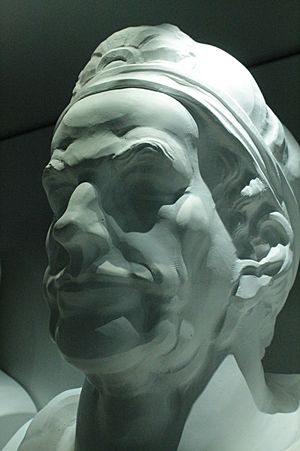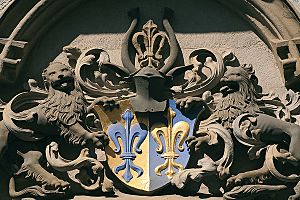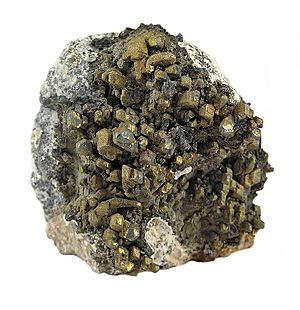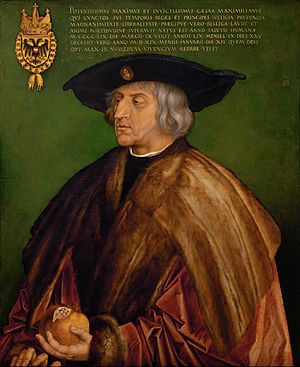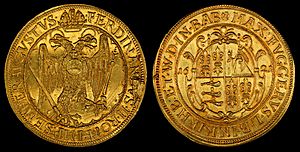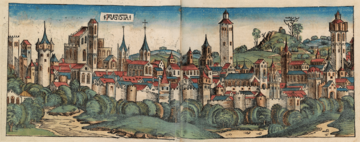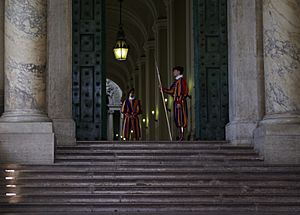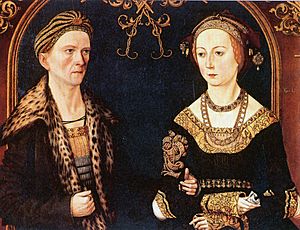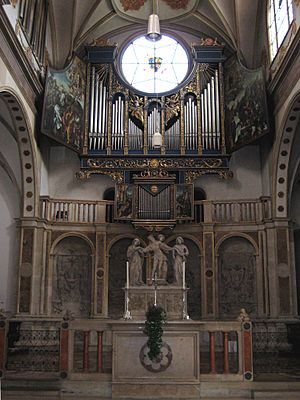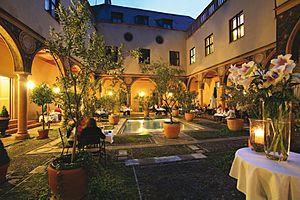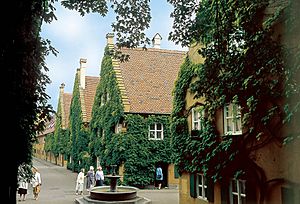Jakob Fugger facts for kids
Quick facts for kids
Jakob Fugger
|
|
|---|---|

Portrait of Jakob Fugger by Albrecht Dürer, 1518 (Staatsgalerie Altdeutsche Meister), Augsburg
|
|
| Born | 6 March 1459 |
| Died | 30 December 1525 (aged 66) Augsburg, Holy Roman Empire
|
| Resting place | St. Anna's Church |
| Spouse(s) |
Sybilla Artzt
(m. 1498) |
| Parent(s) | Jakob Fugger the Elder (father) Barbara Bäsinger (mother) |
| Relatives | Anton Fugger (nephew) |
Jakob Fugger (born March 6, 1459 – died December 30, 1525), also known as Jakob Fugger the Rich, was an incredibly successful German merchant, mining boss, and banker. He came from the famous Fugger family in Augsburg, a city in what was then the Holy Roman Empire.
Jakob helped his family's business grow into a huge company that worked all over Europe. He started learning about business at age 14 in Venice, Italy. He was so wealthy that some people estimate his fortune would be like $400 billion today! This was about 2% of all the money made in Europe at that time.
The Fugger family first became rich from trading textiles (like cloth) with Italy. Their company grew even faster when Jakob and his brothers started banking with powerful families like the House of Habsburg and the Roman Curia (the Pope's government). They also began mining for silver and copper in places like Tyrol and Hungary.
After 1487, Jakob Fugger was the main leader of the family business. He soon had almost complete control over the copper market in Europe. Copper from Hungary was sent all the way to India through cities like Antwerp and Lisbon. Jakob even helped fund the first German trading trip to India.
Jakob Fugger also had a big impact on European politics. He lent money to powerful rulers, helping them gain power. He supported Maximilian I and helped make sure Charles I became the Holy Roman Emperor. Jakob also funded marriages that helped the Habsburg family gain control of kingdoms like Bohemia and Hungary.
Jakob Fugger is remembered for the amazing buildings and foundations he created in Augsburg. He funded a chapel, built between 1509 and 1512, which was Germany's first renaissance building. It holds the tombs of his brothers and himself. In 1521, he founded the Fuggerei, which is the world's oldest social housing complex still in use today.
When Jakob Fugger died in 1525, he left his nephew, Anton Fugger, a massive fortune of over 2 million guilders. He is one of the most famous Germans in history and is still known as "Fugger the Rich."
Contents
Jakob Fugger's Early Life and Learning
Family Background and Education
Jakob Fugger was the tenth of eleven children. His father, Jakob Fugger the Elder, and his mother, Barbara Bäsinger, were already successful merchants in Augsburg. Jakob's grandfather, Hans Fugger, had moved to Augsburg in 1367 and became rich by trading textiles with Italy. By the time Jakob the Elder died, he was one of Augsburg's wealthiest citizens.
Jakob's older brothers, Ulrich and Georg, helped the family business grow across Europe. Around 1470, they opened offices in important trading cities like Venice and Nuremberg.
In 1473, the Fugger family was given a special lily coat of arms. This was because Ulrich Fugger had lent money and provided supplies to Emperor Frederick III. This lily symbol helped tell their family branch apart from another Fugger branch.
Historians used to think Jakob Fugger lived in a monastery as a young man. However, new documents show that by age 14, in 1473, he was already working for his family's business in Venice. He spent many years there, learning about banking and the metal trade. Venice was a major trading hub, making it a perfect place for Jakob to learn. His time in Italy also helped bring the new Renaissance style of building to Germany.
How Jakob Fugger Became a Mining and Banking Giant
Starting in Mining and Metal Trade
Jakob Fugger started his mining business in Salzburg. He lent money to silver mine owners who always needed cash. Instead of just getting a promise to be paid back, Jakob asked for "Kuxe," which were like shares in the mines. This way, he slowly gained control over many mines in the area. This meant mine owners had to sell their silver directly to the Fugger family.
Jakob was in charge of the family's business in Augsburg, Tyrol, Venice, and Rome. Around 1485, they also opened offices in Innsbruck. Jakob first met Archduke Sigismund of the Habsburg family through a small loan. Sigismund owned the mining rights in Tyrol but was always short on money because of his expensive lifestyle. Jakob Fugger helped him pay off a huge war debt. By 1488, Sigismund owed the Fugger family over 150,000 guilders. The Fuggers even paid the royal court's wages! By 1517, the Fugger family was funding more than half of Tyrol's government budget. Because of this, they often had the right to all the silver and copper mined in Tyrol.
Working with Emperor Maximilian I
Jakob Fugger strongly believed in supporting Maximilian I and the House of Habsburg. He saw them as the most powerful family in Germany. Jakob first met Maximilian in 1489.
In 1490, Archduke Sigismund had to give up his power in Tyrol because people accused him of bad management. His lands then went to King Maximilian. Maximilian promised to pay back all the money Sigismund owed to Jakob Fugger.
This made the Fugger business one of Maximilian's most important financial supporters. Maximilian became the Holy Roman Emperor in 1493. Even though he often had money problems, his reign saw the Habsburg family gain control of Spain, Bohemia, and Hungary. This happened not through wars, but through clever marriages, which Jakob Fugger helped pay for.
In 1507, Maximilian I sold several important lands to Jakob Fugger for 50,000 guilders. More sales followed. In 1511, Maximilian made Jakob Fugger a nobleman, and in 1514, he gave him the title of Imperial Count. This meant Jakob could run his business without local noble families interfering. Jakob Fugger eventually became the lord of over 50 small villages.
Some people, like the reformer Martin Luther, criticized Jakob Fugger's business methods. They thought Jakob had too much power over Emperor Maximilian. While this was partly true, Maximilian owed Jakob so much money that he had to keep supporting him to get his money back.
When Maximilian's grandson, Charles V, wanted to become the next Emperor, Jakob Fugger raised over 500,000 guilders to help him. This was a huge part of Jakob's wealth. This money helped convince the seven Prince-electors to choose Charles V. This prevented the French King from becoming Emperor, which would have hurt Jakob's investments.
Expanding Mining and Metal Trade
In 1494, the Fugger company became one of the first "open trading companies" in Europe. It was renamed "Ulrich Fugger of Augsburg and brothers" to show that Jakob and his brothers were equal partners. However, Jakob was becoming the most important decision-maker in the company.
Jakob Fugger made a lot of money from the growing mining and ore trade. He lent money to the Habsburgs and the King of Hungary, and in return, he demanded mining revenues and rights in Upper Hungary. This helped him gain almost complete control over the copper trade in Central Europe.
In 1494, he started a big copper business with his partner, Hans Thurzó, in Neusohl (now in Slovakia). They built smelting plants and distributed copper through offices in cities like Breslau, Leipzig, and Kraków. To transport the copper to ports on the Baltic Sea, Fugger even funded a new road. From these ports, copper was shipped to Russia and also to Lisbon, Portugal, where it was an important item for trade with India. Copper from Tyrol and Hungary made up most of Europe's copper production, giving the Fuggers a very strong position in the market.
The Vatican as a Client
The Fugger family was the first German trading company to have a direct business relationship with the Pope's government in Rome. In 1500, Jakob Fugger lent the Vatican money to build the new St. Peter's Basilica and the Sistine Chapel. To pay Jakob back, Pope Leo X had to tax the German people heavily and sell "indulgences" (pardons for sins). This was very unpopular and helped lead to Martin Luther writing his famous Ninety-five Theses.
After Pope Alexander VI died in 1503, Jakob Fugger worked even more closely with the Vatican. For the new Pope Julius II, Fugger helped pay for the creation of the Swiss Guard in 1505/1506, which still protects the Pope today. Between 1508 and 1524, the Fugger company even leased the Roman mint, making coins for four different Popes.
Overseas Trade Adventures
Trading goods from far-off lands was a smaller part of the Fugger business compared to banking and mining. But Jakob Fugger's early trips to exotic places are still famous.
After Vasco da Gama found a sea route to India, Jakob Fugger got involved in the spice trade. In 1503, he opened an office in Lisbon, Portugal. He was allowed to trade pepper, other spices, and luxury items like pearls and gemstones. He joined other merchants in funding a Portuguese fleet of 22 ships that sailed to India in 1505 and returned in 1506. Even though a third of the goods had to go to the King of Portugal, the trip was still profitable. Later, the King made the spice trade a royal monopoly. However, the Portuguese still relied on the copper supplied by Fugger, which was important for their trade with India.
Jakob Fugger was careful with his overseas investments. He only invested in one other similar trip, a failed Spanish expedition to the Maluku Islands. There's also some evidence he helped fund Ferdinand Magellan's famous voyage around the world.
The Big Challenge for Jakob Fugger
The Fugger company needed huge amounts of money for its mining projects in Hungary. In 1496, Cardinal Melchior von Meckau secretly invested 150,000 guilders in the company, even though the church usually banned earning interest. When he died in 1509, this investment was discovered. The Pope and the Cardinal's family all demanded the money back immediately. This could have made Jakob Fugger's company go bankrupt.
Emperor Maximilian I stepped in to help his banker. He agreed to help Pope Julius II in a war against Venice. In return, Maximilian was recognized as the rightful heir to the Cardinal's money. This meant the debt could be settled by reducing what Maximilian owed Fugger. Fugger also had to give jewels to the Pope. But in return, Maximilian demanded that Fugger keep supporting his military and political plans.
After his brothers Georg (1506) and Ulrich (1510) died, Jakob Fugger became the sole leader of the Fugger business. The company was renamed "Jakob Fugger and Brothers Sons." In the years leading up to his death, Jakob Fugger managed to increase the family's wealth from about 200,000 guilders in 1511 to over 2,000,000 guilders. This was an incredible amount of money!
The Election of Charles V in 1519
Emperor Maximilian died in January 1519. His grandson, Carlos I, inherited the Habsburg lands and wanted to become the next Holy Roman Emperor. Jakob Fugger decided to support Charles V to protect his important investments in the Habsburg family.
Other kings, like Henry VIII of England and Francis I of France, also wanted to be Emperor. Francis I even offered 300,000 guilders to the Prince-electors (the people who chose the Emperor).
Charles I needed Jakob Fugger's money to win. Fugger paid an enormous sum of over 850,000 guilders to the Prince-electors. Jakob himself paid about 550,000 of this. This huge payment led to Charles I being chosen as Holy Roman Emperor on July 28, 1519. What we would call bribery today was common practice back then for electing an Emperor. The amount of money involved was huge because of the strong competition.
A few days later, the Pope allowed Charles I to call himself "Elected Emperor." Charles V was finally crowned Emperor by the Pope in 1530, the last Emperor to have a papal coronation.
Charles V, who now ruled an empire "where the sun never set," owed Jakob Fugger a lot of money. By 1521, the debt was over 600,000 guilders. Charles V paid back some of this by giving the Fugger company the silver and copper mines in Tyrol.
In 1523, there was a debate about limiting how much money trading companies could have and how many businesses they could own. Jakob Fugger spoke up and reminded the Emperor: "It is well known and obvious that Your Imperial Majesty could not have gained the Roman crown without my help." He also demanded that all debts be repaid. This led to all discussions about trade limits being dropped. Jakob Fugger also got the right to mine quicksilver and cinnabar in Almadén, Spain. The Fugger company stayed involved in Spanish mining until 1645.
Jakob Fugger's Family and Legacy
Marriage and Family Life
In 1498, 40-year-old Jakob Fugger married Sybille Artzt, an 18-year-old from an important Augsburg family. This marriage helped Jakob become a "Grand Burgher" of Augsburg and eventually get a seat on the city council. Four years after their wedding, Jakob bought 40,000 guilders worth of jewels for his young wife. He wanted to show that he was as rich as the Habsburgs! However, the jewels were kept hidden in his basement because he feared theft. Jakob and Sybille did not have any children.
Jakob Fugger died on December 30, 1525. His family found that he had over 2 million guilders left after all debts were paid.
Since he had no children, his company and wealth went to his nephews, Raymund and Anton Fugger. Anton managed to double the family's fortune again by 1546.
Religious Beliefs
Jakob Fugger was a Roman Catholic his entire life. He made sure that only Catholic residents could live in the Fuggerei. As the Reformation spread, Augsburg became more Protestant. The Fugger family helped fund the rise of the Habsburg family, who played a big role in fighting against the Reformation.
Jakob Fugger's Amazing Buildings and Foundations
The Fugger Chapel in St. Anna's Church
Jakob Fugger, along with his brother Ulrich, funded the building of the Fugger chapel in the St. Anna church in Augsburg. It was also meant to be the burial place for the three brothers. Construction started in 1509 and finished in 1512. The chapel was designed like Italian burial chapels, showing influences from Venice and Rome. This made it Germany's first Renaissance building. Many famous German artists, like Albrecht Dürer, helped design the inside.
The Fuggerhäuser in Augsburg
The Fugger family already owned houses in Augsburg, but Jakob Fugger built the grand Fuggerhäuser (Fugger Houses) between 1512 and 1515. Inside, the Damenhof (Ladies' Courtyard) was designed like the grand courtyards in Florence, Italy. This made it Germany's first non-religious Renaissance building. The complex was expanded in 1523 to host important guests. The Fuggerhäuser were Jakob and Sybille's private home and the center of their business.
Later Fugger family members made the complex even bigger. Much of it was destroyed during World War II, but it was rebuilt in 1955. The courtyards and some other rooms are still original. The houses are still owned by the Fugger family today.
The Fuggerei: The World's Oldest Social Housing
Starting in 1516, Jakob Fugger paid for the building of a settlement for craftsmen and day laborers who needed help. By 1523, 52 houses were built. It was first called the Fuggerei in 1531. It was meant to help people who were in tough situations through no fault of their own until they could get back on their feet. The yearly rent was just one symbolic guilder (a very small amount of money). In return, residents were asked to say three daily prayers for Jakob and his family.
The Fuggerei was expanded several times and still houses about 150 people today. They still pay the equivalent of one guilder (about 0.88 €) per year! The Fuggerei is a popular tourist spot in Augsburg and has a museum. It is still managed by Jakob Fugger's descendants and funded by a foundation he created in 1521.
Images for kids
See also
 In Spanish: Jacobo Fúcar para niños
In Spanish: Jacobo Fúcar para niños
- List of wealthiest historical figures


